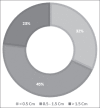Management of Umbilical Hernia in African Children: The Experience of 2146 Cases
- PMID: 37389397
- PMCID: PMC10305955
- DOI: 10.4103/jiaps.jiaps_115_22
Management of Umbilical Hernia in African Children: The Experience of 2146 Cases
Abstract
Aims: Umbilical hernia (UH) is common in African and African-descent children. In high-income countries (HICs), it is considered benign, which is not the case in Sub-Saharan ones. Through this study, we aimed to share our experience.
Materials and methods: A descriptive review was conducted from January 01, 2012 to December 31, 2017 at Albert Royer National Children's Hospital Center. Among the 2499 patients, 2146 cases were included in the review.
Results: UH had a frequency of 6.5%, with patients having a mean age of 2.6 years, with a male preponderance of 63%. Emergency consultation occurred in 37.1%. The symptomatic hernia was present in 90.9%. The congenital type was found in 96%, a history of painful episodes was reported in 46%, and medical and surgical comorbidities were found in 30.1% and 16.4%, respectively. Multimodal anesthesia was used in 93.1%. A lower umbilical crease incision was made in 83.2%, the sac was not empty in 16.3%, and additional umbilicoplasty was performed in 16.3%. During a 14-month follow-up, a complication occurred in 6.5% and mortality in 0.05%.
Conclusion: In our region, the pediatric UH was predominantly symptomatic, with its natural evolution leading to more complications than in HICs. Its management carried acceptable morbidity.
Keywords: African; Senegal; children; management; umbilical hernia.
Copyright: © 2023 Journal of Indian Association of Pediatric Surgeons.
Conflict of interest statement
There are no conflicts of interest.
Figures
References
-
- Brandt ML. Pediatric hernias. Surg Clin North Am. 2008;88:27. - PubMed
-
- Sujka JA, Holcomb GW. Umbilical and other abdominal wall hernias. In: Holcomb GW, Murphy JP, St. Peter SD, editors. Holcomb and Aschcraft's Pediatric Surgery. 7th ed. Edinburgh, London, New York, Oxford, Philadelphia, St. Louis, Sydney: Elsevier; 2020. pp. 780–2.
-
- Keshtgar AS, Griffiths M. Incarceration of umbilical hernia in children: Is the trend increasing? Eur J Pediatr Surg. 2003;13:40–3. - PubMed
-
- Ameh EA. Incarceration of umbilical hernia in children: Is the trend increasing? Eur J Pediatr Surg. 2004;14:218. - PubMed
-
- Meier DE, OlaOlorun DA, Omodele RA, Nkor SK, Tarpley JL. Incidence of umbilical hernia in African children: Redefinition of “normal” and reevaluation of indications for repair. World J Surg. 2001;25:645–8. - PubMed
LinkOut - more resources
Full Text Sources


